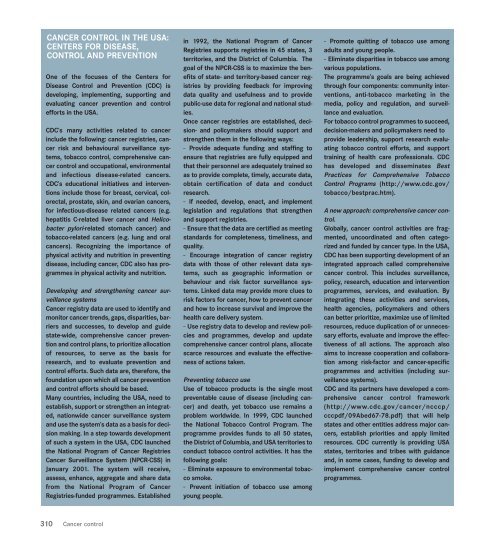world cancer report - iarc
world cancer report - iarc
world cancer report - iarc
Create successful ePaper yourself
Turn your PDF publications into a flip-book with our unique Google optimized e-Paper software.
CANCER CONTROL IN THE USA:<br />
CENTERS FOR DISEASE,<br />
CONTROL AND PREVENTION<br />
One of the focuses of the Centers for<br />
Disease Control and Prevention (CDC) is<br />
developing, implementing, supporting and<br />
evaluating <strong>cancer</strong> prevention and control<br />
efforts in the USA.<br />
CDC’s many activities related to <strong>cancer</strong><br />
include the following: <strong>cancer</strong> registries, <strong>cancer</strong><br />
risk and behavioural surveillance systems,<br />
tobacco control, comprehensive <strong>cancer</strong><br />
control and occupational, environmental<br />
and infectious disease-related <strong>cancer</strong>s.<br />
CDC’s educational initiatives and interventions<br />
include those for breast, cervical, colorectal,<br />
prostate, skin, and ovarian <strong>cancer</strong>s,<br />
for infectious-disease related <strong>cancer</strong>s (e.g.<br />
hepatitis C-related liver <strong>cancer</strong> and Helicobacter<br />
pylori-related stomach <strong>cancer</strong>) and<br />
tobacco-related <strong>cancer</strong>s (e.g. lung and oral<br />
<strong>cancer</strong>s). Recognizing the importance of<br />
physical activity and nutrition in preventing<br />
disease, including <strong>cancer</strong>, CDC also has programmes<br />
in physical activity and nutrition.<br />
Developing and strengthening <strong>cancer</strong> surveillance<br />
systems<br />
Cancer registry data are used to identify and<br />
monitor <strong>cancer</strong> trends, gaps, disparities, barriers<br />
and successes, to develop and guide<br />
state-wide, comprehensive <strong>cancer</strong> prevention<br />
and control plans, to prioritize allocation<br />
of resources, to serve as the basis for<br />
research, and to evaluate prevention and<br />
control efforts. Such data are, therefore, the<br />
foundation upon which all <strong>cancer</strong> prevention<br />
and control efforts should be based.<br />
Many countries, including the USA, need to<br />
establish, support or strengthen an integrated,<br />
nationwide <strong>cancer</strong> surveillance system<br />
and use the system’s data as a basis for decision<br />
making. In a step towards development<br />
of such a system in the USA, CDC launched<br />
the National Program of Cancer Registries<br />
Cancer Surveillance System (NPCR-CSS) in<br />
January 2001. The system will receive,<br />
assess, enhance, aggregate and share data<br />
from the National Program of Cancer<br />
Registries-funded programmes. Established<br />
310 Cancer control<br />
in 1992, the National Program of Cancer<br />
Registries supports registries in 45 states, 3<br />
territories, and the District of Columbia. The<br />
goal of the NPCR-CSS is to maximize the benefits<br />
of state- and territory-based <strong>cancer</strong> registries<br />
by providing feedback for improving<br />
data quality and usefulness and to provide<br />
public-use data for regional and national studies.<br />
Once <strong>cancer</strong> registries are established, decision-<br />
and policymakers should support and<br />
strengthen them in the following ways:<br />
- Provide adequate funding and staffing to<br />
ensure that registries are fully equipped and<br />
that their personnel are adequately trained so<br />
as to provide complete, timely, accurate data,<br />
obtain certification of data and conduct<br />
research.<br />
- If needed, develop, enact, and implement<br />
legislation and regulations that strengthen<br />
and support registries.<br />
- Ensure that the data are certified as meeting<br />
standards for completeness, timeliness, and<br />
quality.<br />
- Encourage integration of <strong>cancer</strong> registry<br />
data with those of other relevant data systems,<br />
such as geographic information or<br />
behaviour and risk factor surveillance systems.<br />
Linked data may provide more clues to<br />
risk factors for <strong>cancer</strong>, how to prevent <strong>cancer</strong><br />
and how to increase survival and improve the<br />
health care delivery system.<br />
- Use registry data to develop and review policies<br />
and programmes, develop and update<br />
comprehensive <strong>cancer</strong> control plans, allocate<br />
scarce resources and evaluate the effectiveness<br />
of actions taken.<br />
Preventing tobacco use<br />
Use of tobacco products is the single most<br />
preventable cause of disease (including <strong>cancer</strong>)<br />
and death, yet tobacco use remains a<br />
problem <strong>world</strong>wide. In 1999, CDC launched<br />
the National Tobacco Control Program. The<br />
programme provides funds to all 50 states,<br />
the District of Columbia, and USA territories to<br />
conduct tobacco control activities. It has the<br />
following goals:<br />
- Eliminate exposure to environmental tobacco<br />
smoke.<br />
- Prevent initiation of tobacco use among<br />
young people.<br />
- Promote quitting of tobacco use among<br />
adults and young people.<br />
- Eliminate disparities in tobacco use among<br />
various populations.<br />
The programme’s goals are being achieved<br />
through four components: community interventions,<br />
anti-tobacco marketing in the<br />
media, policy and regulation, and surveillance<br />
and evaluation.<br />
For tobacco control programmes to succeed,<br />
decision-makers and policymakers need to<br />
provide leadership, support research evaluating<br />
tobacco control efforts, and support<br />
training of health care professionals. CDC<br />
has developed and disseminates Best<br />
Practices for Comprehensive Tobacco<br />
Control Programs (http://www.cdc.gov/<br />
tobacco/bestprac.htm).<br />
A new approach: comprehensive <strong>cancer</strong> control.<br />
Globally, <strong>cancer</strong> control activities are fragmented,<br />
uncoordinated and often categorized<br />
and funded by <strong>cancer</strong> type. In the USA,<br />
CDC has been supporting development of an<br />
integrated approach called comprehensive<br />
<strong>cancer</strong> control. This includes surveillance,<br />
policy, research, education and intervention<br />
programmes, services, and evaluation. By<br />
integrating these activities and services,<br />
health agencies, policymakers and others<br />
can better prioritize, maximize use of limited<br />
resources, reduce duplication of or unnecessary<br />
efforts, evaluate and improve the effectiveness<br />
of all actions. The approach also<br />
aims to increase cooperation and collaboration<br />
among risk-factor and <strong>cancer</strong>-specific<br />
programmes and activities (including surveillance<br />
systems).<br />
CDC and its partners have developed a comprehensive<br />
<strong>cancer</strong> control framework<br />
(http://www.cdc.gov/<strong>cancer</strong>/ncccp/<br />
cccpdf/09Abed67-78.pdf) that will help<br />
states and other entities address major <strong>cancer</strong>s,<br />
establish priorities and apply limited<br />
resources. CDC currently is providing USA<br />
states, territories and tribes with guidance<br />
and, in some cases, funding to develop and<br />
implement comprehensive <strong>cancer</strong> control<br />
programmes.

















